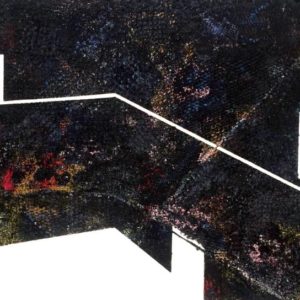One to Watch
 Andrew Rice and the Investigation of the Spaces In-Between
Andrew Rice and the Investigation of the Spaces In-Between
Andrew Rice explores space and histories, both personal and collective, in his minimalist works. He is a practiced printmaker, often working in multiple layers and textures to generate a surface with a “history.” He likens his experience as a printmaker to that of an architect, building layer upon layer of material and texture, and finds inspiration in the degeneration of older buildings, peeling murals, and dislodged bricks. Playing into this notion of hidden spaces and layers of the past, he employs his printmaking process to create his own architectural spaces and hidden histories.
Andrew received an MFA from the University of Utah and a BFA from the University of Colorado. He is currently an Adjunct Professor at the University of Utah, teaching courses in Intaglio, Screenprint, and Drawing. He has had numerous solo shows in the US, China, New York, and Scotland.
What are the major themes you pursue in your work?
I focus on the idea of space in my work–your own personal space, and the spaces we create as both individuals and groups to call our own. I am interested in how we occupy and define that space. I think the deeper root I get at is how we create spaces for ourselves that on one hand isolate us, but also protect us, whether that is individually or collectively.
How did you first get interested in your medium, and what draws you to it specifically?
My primary medium is printmaking. It is what my degree is in and what I currently teach. I started doing the oil stick drawings as a response to my process of printmaking; building layers of texture up to create richer and more interesting values. I was using these found textures that kind of mimicked chain link fencing in a lot of prints and I brought those same textures to the oil sticks. I thought that if I could get the idea of a rich surface with textural history in the etchings and screen prints using these found textures, why not try to get that actual surface come through on the paper, and that is where the oil sticks came in. Building up multiple layers of the oil medium on the paper, my work is left with a physical and tangible surface that shows the layers of the texture.
How has your style and practice changed over the years?
I’ve gotten way looser and more abstract. Even in a lot of the work that still lives in the representational realm, I am looser in my approach.
Can you walk us through your process? Do you begin with a sketch, or do you just jump in? How long do you spend on one work? How do you know when it is finished?
My work can start a lot of different ways. For a lot of the printmaking based work, it starts with some really poor sketches and then I will move to photos for source work, most of the time taking my own rather than trying to source them elsewhere. For the oil stick paintings, I jump right in. I will start by planning out areas of negative space, but then just let the work go from there. I have no real ideas of what the piece will look like when it is finished, which, can sometimes be hard to know when it is finished, ha. A lot of times, deadlines will dictate when something gets finished, but if there is nothing on the horizon and I am just working on some pieces, they can grow and build and develop indefinitely. I would say most of the work in oil takes 2, 3, 4 months to finish because of how long it takes the medium to dry before being able to work over top of it.
If you couldn’t be an artist, what would you do?
I work with music and don’t discriminate on what is on. I will put on any and everything and a lot of times, the music just becomes background noise and not always something I am paying attention. This is why I can’t listen to podcasts while I work. I end up having no idea what is being talked about as I’m constantly tuning in and out. I remember listening to that podcast, Serial when it was just coming out and had a big show I was working on in my studio. I ended up having to re-listen to just about every episode 2-3 times just to follow the story! After that, I decided not to put myself through that again and stick to music.
If you could only have one piece of art in your life, what would it be?
A Richard Serra sculpture, and since this is fantasy, I would want a Serra sculpture I could live inside of.


















